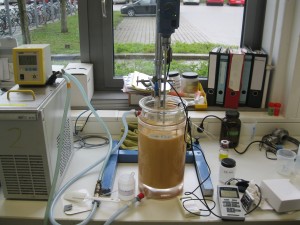
In the lab: Lentil Protein Extraction in reactor
One of the specific PROTEIN2FOOD objectives is the development of environmentally sustainable techniques to produce protein ingredients from high quality and high quantity protein crops.
Protein ingredients are developed by extracting high-quality proteins from new nutritious protein crops (pseudocereals) and grain legumes that are high in protein. New methods and processes need to be developed that can convert these crops into protein ingredients for new sustainable food products. With the main goals of optimizing the energy needed for the extraction process, researchers at Fraunhofer IVV and the University of Copenhagen have developed new processes to obtain these protein-rich fractions.
One technique that is used is dry fractionation. In this process, the seeds are first dehulled and milled. Afterward, dry fractioning happens through sieving with different mesh sizes called sieve classification. Alternative methods to separate starch and protein are fine milling and air classification.
The best-suited extraction method depends on the raw material; while air classification is more suitable for starch containing legumes, sieve classification is more appropriate for the high-quality protein crops. The impact of milling combined with sieve classification or air classification, analysed in dry fractionation trials, proved to be suitable for providing protein-rich flours of quinoa, amaranth, buckwheat and faba bean with protein contents ranging from 25-65%. A protein content of 65% is high for a dry fraction process. In all the processes the protein content was at least doubled compared to the seed.
Another processing method, investigated on a lab scale, is mild aqueous extraction of proteins from lupin, quinoa, faba bean and lentil. After finding the optimal method for each raw material, protein products with protein contents that can range from 51% (quinoa) to more than 90% (lupin, lentil) were achieved.
Generally, with all the fractionation processes efficient protein enrichment and purification was accomplished. The resulting new protein fractions showed a 2-3 times higher protein content than the corresponding raw materials. All the prospected processes were scaled-up to pilot plant or industrial scale and provided new protein concentrates or isolates for food development which are not on the market so far.
